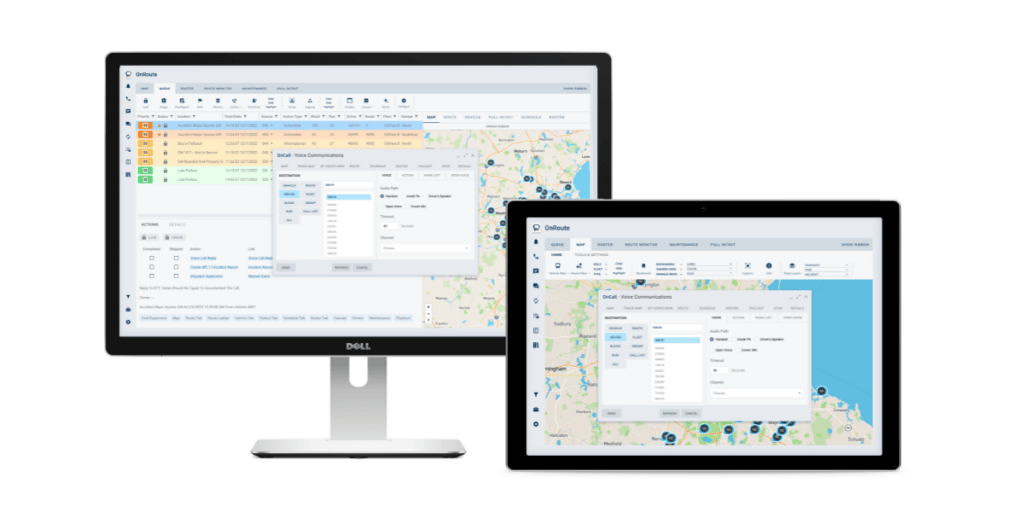
In This Blog
Say Goodbye to Radios: Vontas OnCall can replace your outdated radio systems with a VoIP platform that uses public cellular networks, cutting costs and boosting reliability.
Flexible Options for Every Agency: Choose between OnCall for standalone VoIP or Vontas OnRoute VoIP for hybrid integration with Vontas OnRoute CAD/AVL.
Fast, Scalable Deployment: Agencies like DART and MBTA implemented OnCall across hundreds of vehicles in days, saving time and delivering rapid ROI
Built for Real-World Transit: Features like text-to-speech, call recording, and automatic network switching ensure clear, uninterrupted communication
Better Service, Lower Costs: OnCall improves safety, reduces infrastructure expenses, and enhances the rider experience with real-time updates
Every successful transit operation depends on clear and reliable communication. However, with traditional radio systems becoming outdated, alongside increasing maintenance expenses, limited coverage, and costly infrastructure, many transit agencies are actively seeking a more modern solution. Enter Vontas OnCall : a purpose-built Voice over Internet Protocol (VoIP) platform tailored specifically for public transit.
Unveiled at this year’s ThinkTransit Product Showcase in Kansas City, OnCall provides a seamless way to enhance connectivity and dependability, while eliminating the technical frustrations associated with legacy radio systems. Andrea Costa, Product Manager at Vontas, introduced OnCall and shared real-world examples of why agencies are turning to this powerful communications platform.
Why Agencies Are Moving Away From Radio
At ThinkTransit, Costa recounted the challenges agencies face with aging radio infrastructure. Whether it’s the high cost of maintaining radio towers, delays caused by dead zones, or disruptions due to shared bandwidth with emergency services, it’s clear that many agencies are working with outdated systems that no longer meet the demands of today’s rider —or operations teams.
These issues can be costly. When a radio tower goes down, or a dispatcher loses communication with a vehicle, the downstream effects can delay service, impact rider safety, and increase operational risk. And with capital budgets under pressure, repairing or replacing radio systems is often out of reach.
Vontas OnCall solves these problems by leveraging public cellular networks to deliver clear, uninterrupted communication—without the cost and complexity of managing radio infrastructure.
Two Flexible Offerings to Fit Agency Needs
One of the many strengths of Vontas OnCall is its flexibility. Transit agencies come in all shapes and sizes, and OnCall offers two options designed to match different needs and goals.
OnCall is a standalone VoIP solution that provides reliable, high-quality communication without the need for traditional radio towers. It’s a perfect fit for agencies focused on affordability and scalability, particularly those seeking to modernize with minimal infrastructure investment.
Vontas OnRoute VoIP integrates directly with Vontas OnRoute, offering intelligent switching between public cellular networks and private radio. This hybrid approach ensures continuity, even when one network goes down – perfect for agencies with mission-critical routes or unique coverage challenges.
This dual-option model empowers agencies to scale communications to align with their operational goals and technological environment.
Quick Implementation for Immediate Benefits
Modernizing communication shouldn’t come with a long timeline or service interruptions. Two agencies that adopted OnCall—Dallas Area Rapid Transit (DART) and the Massachusetts Bay Transportation Authority (MBTA)—proved just how easy implementation can be.
At DART, OnCall was successfully deployed. across 375 vehicles in just two weeks. The quick setup required minimal infrastructure changes and resulted in immediate operational improvements.
At MBTA, the implementation was even faster. In just 48 hours, the agency installed OnCall on 750 vehicles. As part of MBTA’s Orion upgrade, OnCall replaced manual radio checks with automated system diagnostics and status reporting. This change saved up to 10 minutes per driver per shift, translating into 45 hours saved per weekday driver and an estimated ROI of $700,000 annually.
Designed for the Realities of Transit Operations
Beyond its ease of deployment, Vontas OnCall meets the real-world communication demands of transit teams. It enables text-to-speech messaging for consistent, audible communication from dispatchers and includes call recording and storage features to support transparency and incident review.
Its multi-mode backup ensures fail-safe operation by automatically switching between public cellular and private radio networks, allowing for clear, uninterrupted communication – even in low-signal environments or across mixed fleets.
The solution also integrates seamlessly with Vontas solutions like OnRoute and OnTransit, enabling agencies to create a fully connected operations – from real-time vehicle location and predictive maintenance to instant, reliable communication between vehicles and dispatch.
The Bigger Picture—Improved Safety, Lower Costs, Better Experience
From a financial standpoint, OnCall reduces both capital and operational costs by avoiding expensive private infrastructure. Its use of public cellular networks lowers overhead while delivering consistent performance.
Operationally, OnCall allows agencies to move faster and respond with agility. Whether rerouting during a detour, responding to an emergency, or coordinating a special event, OnCall equips teams with the tools to act quickly and keep passengers informed.
Most importantly, this reliability extends to the rider experience. Communication delays can impact service and trust. OnCall closes those gaps, helping agencies deliver the kind of real-time updates and confident service riders expect – without added complexity.
It’s Time to Leave Radio Behind
The future of transit communication is in the cloud, on the road, and ready to deploy. OnCall offers agencies a better way to communicate, manage service, and adapt to what’s next. It’s affordable, fast to implement, and built to grow alongside your operations.
Learn how your agency can transition from legacy radio to a modern VoIP solution with fewer disruptions, lower costs, and greater flexibility.
